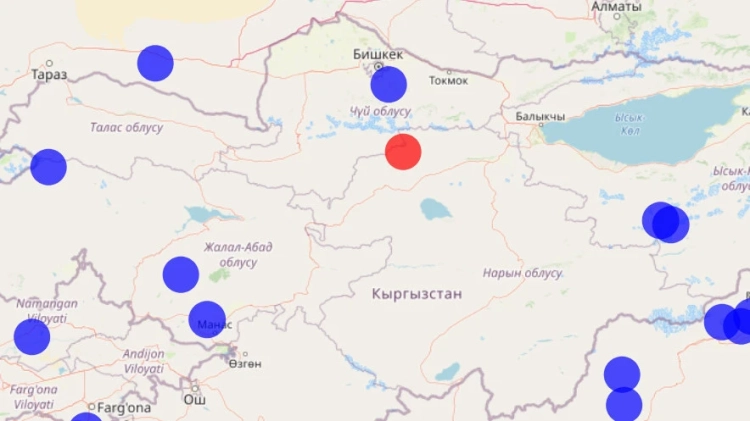
The Prime Ministers of Kazakhstan, Karim Massimov, and Kyrgyzstan, Temir Sariev, discussed issues...

The length of the new highway 'Almaty – Issyk-Kul' will be 280 kilometers. These figures...

The Ministry of Culture, Information, and Tourism of the Kyrgyz Republic reports on the rules for...

The cable car from Almaty to Issyk-Kul could pay off in five years. This was reported by the head...

The meeting with representatives of the tourism business of Kazakhstan in Almaty was successful....

The 12th Open City Championship in bodybuilding, classic bodybuilding, fitness, bodyfitness,...

Last weekend, the fifth international championship of Kyrgyzstan in pole acrobatics was held at...

Igisinov Sagynbek Imankulovich (1937), Doctor of Medical Sciences (1993), Professor (2000) Kazakh....

Live concert at the bar 'Chemodan Zusmanovich'. Concert of singer nasiafromasia (Almaty)...

Dear Ladies and Gentlemen!...

Dzhoshibaev Seikhan (1939), Doctor of Medical Sciences (1981), Professor (1994), Corresponding...

Kumekov Bolat Eshmukhambetovich (1940), Doctor of Historical Sciences (1994), Professor (1996),...

According to information from seismologists, tremors were not detected in Almaty; however, the...

In terms of trade volume with Kyrgyzstan, Kazakhstan ranks third. Kyrgyzstan trades with a total...

From May, citizens of the Kyrgyz Republic will be able to stay for 30 days without registration in...

Ryzhkov Vladimir Nikolaevich Born in 1954. Graduated from the Frunze Polytechnic College with a...

Kyrgyzstan borders one of the most developed regions of Kazakhstan — Almaty. This proximity...

Kyrgyzstan is known as a multinational state where numerous ethnic groups live together in harmony....

Usually, when you ask about the tourist resources of the city of Bishkek, it tends to lead to a...

The foreign ministers of Kazakhstan and Kyrgyzstan have signed a cooperation program for 2014-2015...

Joshibaev Seithan Joshibaevich Doctor of Medical Sciences, Professor, Corresponding Member of the...

Airlines providing air transportation services for passengers and cargo to various destinations....

Mountain Passes of Issyk-Kul Region San-Tash Pass (height 2195 m) is located in the Issyk-Kul...

Kozakmetov Kaykimseit Khamitovich (1937), Doctor of Physical and Mathematical Sciences (2002)...

Kara-Balta, which translates as "Black Axe," is one of the youngest cities in the Kyrgyz...

In the final of the Toguz Korgool among women's teams, the teams of Kyrgyzstan-1 and...

The Russian band WILDWAYS is preparing for a tour in Central Asia. The band will visit 4 cities in...

Bugazov Anvar Khuzaevich (1958), Doctor of Philosophy (2000). Dungan. Born in Frunze. Graduated...
Osh - "The Southern Capital" of Kyrgyzstan. The city of Osh is the administrative center...

China is a vast country rich in tourist resources. The country is abundant in attractions and...

Zailiyskiy Alatau A mountain range in the northwest of the Tian Shan (on the border of Kazakhstan...

Belekov Zhanek Omoshevich (1960), Doctor of Medical Sciences (1997), Professor. Kyrgyz. Born in...

Museum-Reserve The museum-reserve was established in 1949 with the creation of the Osh Regional...

On November 7, 2014, in the city of Astana, the 4th meeting of the Supreme Intergovernmental...

Kutmanova Ainura Zarylbekovna (1962), Doctor of Medical Sciences (2002) Kyrgyz. Born in Osh,...

The collectible coins of the series "Kyrgyzstan on the Great Silk Road" are dedicated to...

Over the past five years, the number of serviced flights at OJSC "Manas International...

The Jalal-Abad Historical and Local Lore Museum is located in the administrative center of the...

Chertkov Vladislav Alexandrovich (1932), Doctor of Agricultural Sciences (1989), Professor (1993)...

The Kyrgyz cultural project Silk Road Fest has unofficially been recognized as the best and has...

Iskenderova Dzhamilya Abykaevna (1963), Doctor of Physical and Mathematical Sciences (2002)...

International Personal Growth Festival "SAMADHI"-2015 July 23-27, CT...

In addition, there will be 8 polling stations operating in Turkey in cities such as Ankara,...

Kyrgyz models Islam Sultanov, Shahzada Baltabaeva, and Urusgul Kenzhebaeva have gone to the...

From the settlement Molotovsky - to the city of Kainды The city of Kainды is located not far from...

The airline "Avia Traffic Company" was founded on June 20, 2003. The organizational and...

Akmetova Nurlan Alymkulovna (1954), Doctor of Pedagogical Sciences (2002) Kyrgyz. Born in the...

The Saka tribes were divided into three parts. In the southern regions of Kyrgyzstan lived the...